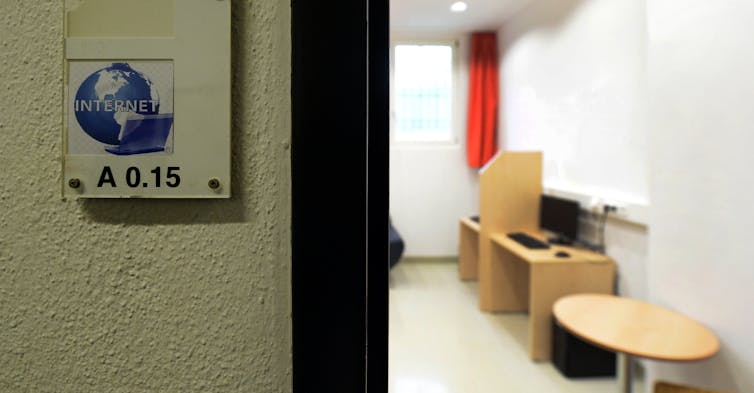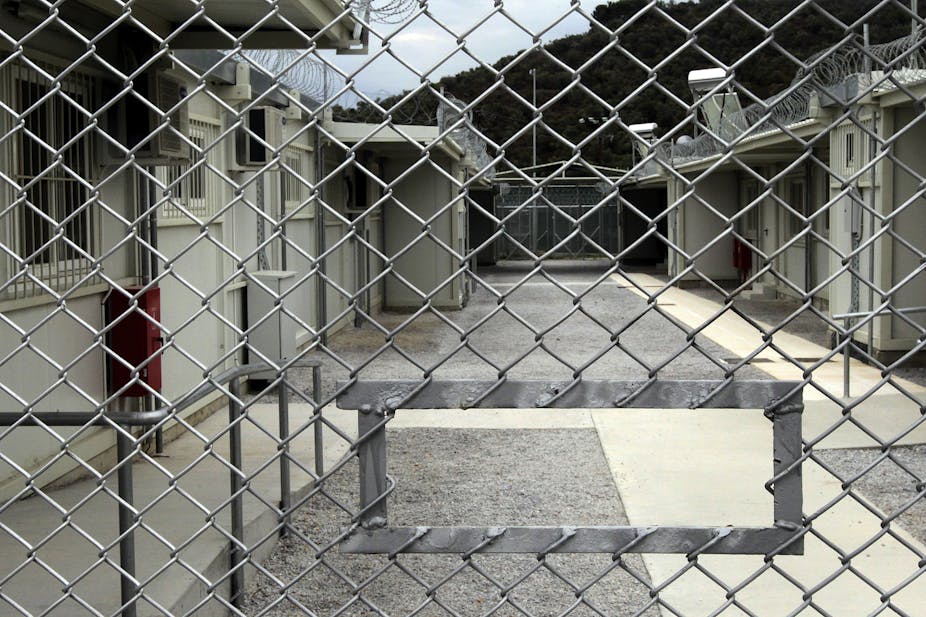Since the 1980s, all major Western states practice what they call civil or administrative confinement of undocumented immigrants and non-citizens. But this practice of putting undocumented immigrants – as well as asylum seekers – in detention centres does not deter people from seeking sanctuary in the West. Instead, it feeds a growing private prison industry and can portray genuine asylum seekers, who are often deeply scarred by trauma, as criminals who pose a security threat.
The US has the highest number of incarcerated non-citizens in the world: a population which grew from around 240,000 in 2005 to 400,000 in 2010. Since 2009, there has been a congressional mandate to fill 34,000 immigration detention beds each night. More than half of these beds are placed in privately run detention facilities, run by companies such as CoreCivic (formerly the Corrections Corporation of America), who lobbied for the passing of this mandate.
In the US, immigration detention centres were the fastest growing market for private prison companies, even before the election of Donald Trump – who campaigned on a pledge to start deportations of some of the estimated 11m undocumented migrants in the country. Among the few companies that saw a rise in value on the stock market immediately after Trump’s victory were CoreCivic and the Geo Group, another of the world’s largest private prison companies.
The number of detainees, according to the latest numbers, has also been growing in many EU countries since the 1990s. The UK had capacity to detain 250 people in 1993. It held 27,594 people in detention in March 2012 and 32,163 in March 2016. France detained 28,220 in 2003 and 47,565 in 2015. Sweden placed 1,167 immigrants in detention in 2006 and 3,959 in 2015. In the past ten years or so Australia’s detainee population has fluctuated. In 2009, there were 375 detainees, a number that sharply rose to 5,697 in 2013, and then dropped to 1,807 in January 2016.
Statistics for Greece and Italy, the two main first countries of entry for asylum seekers to the EU, are not readily available. In 2015 Italy detained 5,242 people, while Greece had a detention capacity of 6,290 in 2013.
Conditions vary
There is significant variation in living conditions and rights of detainees held in different countries. The US and Italy have for-profit, privately run detention centres. In Sweden and the Netherlands, detention centres are fully operated by central government agencies. In Germany, they are managed by regional governments, which then contract out security and care services to private companies. In the UK and Australia, detention centres are also outsourced to private companies, while in France, the regional and local authorities operate detention centres but contract NGOs to provide certain services. Since 2014, Greece has been attempting to privatise parts of its immigration detention machinery, but with no apparent success.

Sweden stands out with its relatively comprehensive provision of services. Immigrant detainees in Sweden wear their own clothes and rooms are shared between two persons, with 20 detainees sharing a common space designated as an immigration reception centre. The common space is equipped with couches, a television, pool table and dining furniture. Detainees also have 24/7 accesses to computers with internet, telephones and visitation rooms.
This practice stands in stark contrast to the US, where detainees wear colour-coded prison-style uniforms and are monitored by CCTV. Access to outdoor activities is limited to a few hours a day and common spaces have prison-style stainless steel furniture bolted to a concrete floor. There is no easy access to a telephone, let alone a computer with internet access.
In the US, some detainees have been forced to work for US$1-3 a day, while in Britain, detainees are given the option to work for around £1/hour, cleaning or serving food. In Sweden, by contrast, detainees are given a daily allowance to spend as they like.
In Sweden and France detainees also have the right to free legal aid. In the US detainees are in most cases not even informed of their basic rights. There was no attorney to represent 84% of those in removal proceedings in 2013. That is significant, since a Human Rights First study showed that asylum seekers in detention that had legal representation were three times more successful with their asylum applications than those without.
Human suffering, everywhere
Whatever the conditions, the human suffering in immigration detention centres is undeniable. In 2015, an Australian Human Rights Commission report found a third of children in immigration detention centres had a mental health disorder that required psychiatric support.
In the US, mothers traumatised by gang and sexual violence have been found living in freezing detention facilities with their children. US customs and border patrol officials unofficially explained to a reporter for Mother Jones that detention “facilities were never designed to house migrants for more than a half day or so”. Detainees voiced their theory: “The cold is part punishment, part deterrent.”
One rejected Afghan asylum seeker in Sweden who had been detained in the late 2000s told me it felt like being in prison. He was subsequently released and granted asylum because conditions in Afghanistan had worsened since his initial application.
Criminalising immigrants
Western countries invoke a variety of reasons for detaining non-citizens. These include ensuring the deportation of rejected asylum seekers, detaining non-citizens who pose a “risk to the public” and detaining asylum applicants who pose a risk of absconding following a rejected application.
Amid this hardship, a 2015 Odysseus Network report on immigration detention in the EU found that “increasing use of detention worldwide has not reduced irregular migration flows”.
Evidence provided by the UN in the case of Australia shows that detention centres criminalise and grossly mistreat a lot of people who have a legal right to move freely. The UN has also accused Sweden of using immigration detention of rejected asylum seekers too often.
In March 2017, the Trump administration announced plans to create 20,000 new beds to indefinitely detain asylum seekers. Targeting mainly women and children from Central America, the policy would force mothers to choose between returning to their home countries with their children or pursuing their asylum applications separated from them in detention.
The logic of this criminalising and dehumanising plan follows well-established trends. Although US Immigration and Customs Enforcement (ICE) has long claimed to prioritise detaining and deporting “aliens” who have committed criminal offences, the statistics betray the opposite reality. A report by Syracuse University found that between 2008 and 2012, 77.4% of those detained by ICE had no criminal record. Undocumented foreign nationals in 2012 were more likely to be detained if they committed a traffic offence than if they committed homicide, rape, robbery or aggravated assault.
Under the illusion of national security, more people who are seeking sanctuary or economic opportunity in the West are being marginalised and dehumanised even further.
Correction: This article was amended on April 22 to show that in 1993, the UK government had the capacity to detain 250 people, rather than detaining that many.

